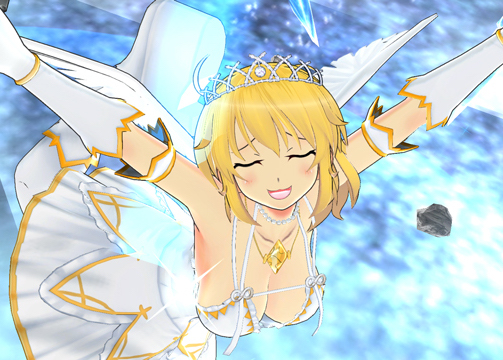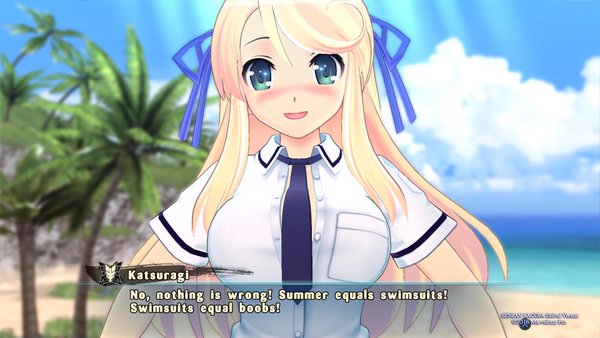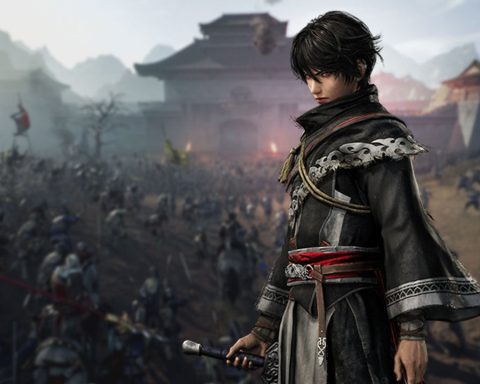Review by Matt S.
Tigger, from Winnie the Pooh, would love Senran Kagura. “Why?” I hear you ask? Well, it’s simple; Tiggers like bouncing, and there sure as hell is a lot of bouncing going on in this game.
Related reading: The second issue of the DDNet Magazine focuses entirely on the topic of fan service, and has an excellent piece on Senran Kagura by Pete. Read it here.
I really do mean a lot. The entire genesis of the Senran Kagura series in the first place was to stick a bunch of girls, with boobs large enough that they’re going to need a hell of a chiropractor when they get older, into a brawler fighting game that provided ample opportunity for those girls to have their clothing torn off them. It wasn’t enough that the girl’s chests wobble with the most ridiculous jelly physics with every movement they make; Senran Kagura also wanted to give us all a good, intimate view of lingerie and, often, the most ridiculously arbitrarily concealed nudity you’ve ever seen.
You’re going to know if this game is for you based on that description alone. It’s so overt in its sexualisation behaviour and intention that it almost makes the rest of the gameplay obsolete; the main point of the game really is to shove the giant boobs of young women in your face, and it succeeds in that admirably. The producer behind the series, Kenichiro Takaki, completely owns what he’s doing, and that’s to his great credit. He of course knows his series is exploitative and that it objectifies its characters, and he simply doesn’t care. Where Koei Tecmo goes to great pains to argue that its own Tigger-service series, Dead or Alive, is not offensive to the Japanese market (as a whole), Takaki simply does not care if he offends anyone. He likes boobs, he’s made a game that celebrates them. Simple.
The into music clip to Senran Kagura is eye opening alright. #PS4share https://t.co/sSxskUEJyG pic.twitter.com/WbXcCKfgEP— Digitally Downloaded (@DigitallyDownld) March 12, 2016
It’s actually kind of liberating that the producer takes such ownership of the exploitative nature of Senran Kagura. I’ve argued in the past that there’s actually much more to the series than its sexuality, once you start digging into the characters and fully taking in the plot, and that’s certainly the case with Senran Kagura: Estival Versus, too. It’s perhaps less interested in building out its characters, because there are more of them and it basically assumes that you already know who they are from previous games anyway, but as a continuation of the overall Senran Kagura narrative, Estival Versus knows what it’s doing and the way it develops the relationships between the characters is minimalist, but effective. There is a surprising amount of reading to be done between combat, too, as the narrative frequently dips into traditional Japanese themes around pride, honour, and family responsibility, so if you do want to take it more serious than a pure Tigger-service game, then you can, and it has some fairly poignant statements to make along the way.
But because Takiki so happily owns the explotative nature of his game, it’s almost redundant for me to even bother highlighting this depth beyond the exploitation. The game is what it is, Takiki insists, so you’re either on board with it, or you’re not.
I’m on board with it. I can totally appreciate that there’s a strong social criticism to make of the Senran Kagura franchise, but I find the hyperbole of Takiki’s approach to design to be too silly to take seriously. And, as with most of Tamsoft’s games, I’m happy to take them on board for their fanservice and silliness as my equivalent of Call of Duty; I recognise its issues, but I have too much fun to really care. Grab me when I’m half way through a bottle of red, and I’d be more than happy to debate both sides of that more academic (and, in fairness, important) coin by myself. Because there are two sides to it. But grab me when I’m half way through a six pack of beer and you’ll find me on the floor laughing as I’m playing.
I mean, in this game there’s a scene where, after defeating a boss opponent, there’s a cut scene where she’s stripped naked, hurled on to a taiko drum, at which point another ninja beats on her bare legs, which happen to have landed draped over the drum face. This scene actually comes out of nowhere and is every bit as ridiculous as it sounds. Many of the character personalities are equally ridiculous. One girl that has a severe masochistic edge and loves to be beaten on or verbally abused. Another has an unhealthy fixation on grabbing other girl’s boobs. This characterisation doesn’t exactly lead to nuanced, deep individual characters, but it’s hugely effective in giving each character a distinct personality, and you’ll certainly develop favourites from among them as you play along. Wisely, there are no men involved in this game at all. Throwing men in there would have lent the game gender politics and, likely, sexualised violence themes, and that would have been too much. As it is, this is voyeuristic, but not sleazy about it. The girls are empowered in the way they exist in their space and narrative, and that’s a good thing.
It’s worth noting that the combat system in Estival Versus is actually really good. We’re not talking about something that’s going to be remembered as a brawler of classic quality generations down the track, but compared with Tamsoft’s other games, from Hyperdimension Neptunia U: Action Unleased to Onechanbara, this one is far more competent mechanically, and offers plenty of variety in what you’ll be doing. Aside from a camera that rarely likes to get in the way of you actually seeing what’s around you, Estival Versus makes it very easy to wade into hordes of dozens of enemies and dice and slice with precision, variety, and style.
In fact, the combat system reminded me more of the precision of one of Koei’s Warriors game… if those games had the hordes being stripped down to their underwear after a couple of successful attacks were landed. And those Warriors had the ability to power themselves up by stripping themselves naked. Each girl in Estival Versus has the ability to take on a ninja form, which involves her taking it all off, pulling a ninja scroll from somewhere unmentionable (and I really do mean that. The scrolls that pop up through the boobs are the… least eye opening of these scenes), and then re-dressing in an alternative costume that makes her much more powerful. It’s a simple mechanic, more there for show than anything else, as it doesn’t actually change how your hero moves and fights; she’s just better able to handle the hordes around her.
— Digitally Downloaded (@DigitallyDownld) March 13, 2016
What does change the way the game plays completely is if you decide to skip past all the pretence of the girls wearing costumes and simply have them fight in their underwear. It’s an option that’s only a button away, and when you do that the girl becomes super strong, but loses some of her mobility (which is perhaps the reverse order I might have expected). It’s a real risk to activate this ability, but if you’re confident on your ability to time blocks and parries, then it’s also a very quick way to mow down hordes and bosses, which is a good way to help you get a good score. Or perhaps you just want to have your favourite girl fighting in her delicates. I’ll admit I failed a couple of missions because I simply couldn’t resist doing just that.
There are differences in the way the girls move and fight, though for the most part their actual abilities aren’t that different. The narrative gives you the opportunity to play with them all, as it works you through a fantasy scenario where a bunch of teams of ninjas have been pulled together onto the one island and forced into combat sports with the ultimate reward being a chance to achieve a kind of enlightenment. Each of the girls can be heavily customised in what she’s wearing, from her underwear through to costumes and swimsuits. As a Tamsoft game, the level of detail in the costuming is really quite impressive. Oddly, however, I did miss the ability that other recent Tamsoft games have implemented; the ability to pause the action mid-sequence and then manipulate the camera to get good screenshots. I really liked this feature in Onechanbara, especially, and thought it would be a no-brainer here.
Anyhow, that aside, a little like Tomonobu Itagaki, Takaki is a transgressive artist, in a punk-like sense of the word. He is perfectly content making the games that he does, with or without the support of the community (or indeed knowing full well that his work will draw robust criticism). His games have developed a fan base though because, controversial as the content in them might be, they happen to also be genuinely excellent games.
And, hell, some people simply like pretty girls in their underwear. Why we can accept that it’s perfectly healthy to enjoy putting bullets through people’s heads, but heaven forbid a game have a nearly naked girl, I will honestly never understand.
Senran Kagura: Estival Versus is great fun, combining the rawest of Japanese-style raunch humour with a tight and mechanically sound combat system. Frankly, I don’t think there’s much else the developer could have done to nail the brief on what this game set out to achieve, and the PlayStation 4 has a new king of exploitation entertainment on it.
– Matt S.
Editor-in-Chief
Find me on Twitter: @digitallydownld










